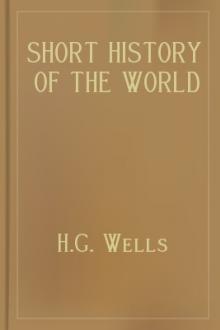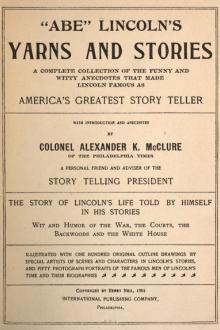A Short History of the World, H. G. Wells [beach books .TXT] 📗

- Author: H. G. Wells
- Performer: -
Book online «A Short History of the World, H. G. Wells [beach books .TXT] 📗». Author H. G. Wells
The greater portion of these American tribes never rose above a hunting nomadic Neolithic life. They never discovered the use of iron, and their chief metal possessions were native gold and copper. But in Mexico, Yucatan and Peru conditions existed favourable to settled cultivation, and here about 1000 B.C. or so arose very interesting civilizations of a parallel but different type from the old-world civilization. Like the much earlier primitive civilizations of the old world these communities displayed a great development of human sacrifice about the processes of seed time and harvest; but while in the old world, as we shall see, these primary ideas were ultimately mitigated, complicated and overlaid by others, in America they developed and were elaborated, to a very high degree of intensity. These American civilized countries were essentially priest-ruled countries; their war chiefs and rulers were under a rigorous rule of law and omen.
These priests carried astronomical science to a high level of accuracy. They knew their year better than the Babylonians of whom we shall presently tell. In Yucatan they had a kind of writing, the Maya writing, of the most curious and elaborate character. So far as we have been able to decipher it, it was used mainly for keeping the exact and complicated calendars upon which the priests expended their intelligence. The art of the Maya civilization came to a climax about 700 or 800 A.D. The sculptured work of these people amazes the modern observer by its great plastic power and its frequent beauty, and perplexes him by a grotesqueness and by a sort of insane conventionality and intricacy outside the circle of his ideas. There is nothing quite like it in the old world. The nearest approach, and that is a remote one, is found in archaic Indian carvings. Everywhere there are woven feathers and serpents twine in and out. Many Maya inscriptions resemble a certain sort of elaborate drawing made by lunatics in European asylums, more than any other old-world work. It is as if the Maya mind had developed upon a different line from the old-world mind, had a different twist to its ideas, was not, by old-world standards, a rational mind at all.
This linking of these aberrant American civilizations to the idea of a general mental aberration finds support in their extraordinary obsession by the shedding of human blood. The Mexican civilization in particular ran blood; it offered thousands of human victims yearly. The cutting open of living victims, the tearing out of the still beating heart, was an act that dominated the minds and lives of these strange priesthoods. The public life, the national festivities all turned on this fantastically horrible act.
Modelled from drawing by Prof. Rutot
The ordinary existence of the common people in these communities was very like the ordinary existence of any other barbaric peasantry. Their pottery, weaving and dyeing was very good. The Maya writing was not only carven on stone but written and painted upon skins and the like. The European and American museums contain many enigmatical Maya manuscripts of which at present little has been deciphered except the dates. In Peru there were beginnings of a similar writing but they were superseded by a method of keeping records by knotting cords. A similar method of mnemonics was in use in China thousands of years ago.
In the old world before 4000 or 5000 B.C., that is to say three or four thousand years earlier, there were primitive civilizations not unlike these American civilizations; civilizations based upon a temple, having a vast quantity of blood sacrifices and with an intensely astronomical priesthood. But in the old world the primitive civilizations reacted upon one another and developed towards the conditions of our own world. In America these primitive civilizations never progressed beyond this primitive stage. Each of them was in a little world of its own. Mexico it seems knew little or nothing of Peru, until the Europeans came to America. The potato, which was the principal food stuff in Peru, was unknown in Mexico.
Age by age these peoples lived and marvelled at their gods and made their sacrifices and died. Maya art rose to high levels of decorative beauty. Men made love and tribes made war. Drought and plenty, pestilence and health, followed one another. The priests elaborated their calendar and their sacrificial ritual through long centuries, but made little progress in other directions.
THE old world is a wider, more varied stage than the new. By 6000 or 7000 B.C. there were already quasi-civilized communities almost at the Peruvian level, appearing in various fertile regions of Asia and in the Nile valley. At that time north Persia and western Turkestan and south Arabia were all more fertile than they are now, and there are traces of very early communities in these regions. It is in lower Mesopotamia however and in Egypt that there first appear cities, temples, systematic irrigation, and evidences of a social organization rising above the level of a mere barbaric village-town. In those days the Euphrates and Tigris flowed by separate mouths into the Persian Gulf, and it was in the country between them that the Sumerians built their first cities. About the same time, for chronology is still vague, the great history of Egypt was beginning.
These Sumerians appear to have been a brownish people with prominent noses. They employed a sort of writing that has been deciphered, and their language is now known. They had discovered the use of bronze and they built great tower-like temples of sun-dried brick. The clay of this country is very fine; they used it to write upon, and so it is that their inscriptions have been preserved to us. They had cattle, sheep, goats and asses, but no horses. They fought on foot, in close formation, carrying spears and shields of skin. Their clothing was of wool and they shaved their heads.
Each of the Sumerian cities seems generally to have been an independent state with a god of its own and priests of its own. But sometimes one city would establish an ascendancy over others and exact tribute from their population. A very ancient inscription at Nippur records the “empire,” the first recorded empire, of the Sumerian city of Erech. Its god and its priest-king claimed an authority from the Persian Gulf to the Red Sea.
Note the cuneiform characters of the inscription, which records the building of a temple to a Sun God
At first writing was merely an abbreviated method of pictorial record. Even before Neolithic times men were beginning to write. The Azilian rock pictures to which we have already referred show the beginning of the process. Many of them record hunts and expeditions, and in most of these the human figures are plainly drawn. But in some the painter would not bother with head and limbs; he just indicated men by a vertical and one or two transverse strokes. From this to a conventional condensed picture writing was an easy transition. In Sumeria, where the writing was done on clay with a stick, the dabs of the characters soon became unrecognizably unlike the things they stood for, but in Egypt where men painted on walls and on strips of the papyrus reed (the first paper) the likeness to the thing imitated remained. From the fact that the wooden styles used in Sumeria made wedge-shaped marks, the Sumerian writing is called cuneiform (= wedge-shaped).
Recovered from the Tombs at Abydos in 1921 by the British School of Archæology. They give evidence of early form of block printing
An important step towards writing was made when pictures were used to indicate not the thing represented but some similar thing. In the rebus dear to children of a suitable age, this is still done to-day. We draw a camp with tents and a bell, and the child is delighted to guess that this is the Scotch name Campbell. The Sumerian language was a language made up of accumulated syllables rather like some contemporary Amerindian languages, and it lent itself very readily to this syllabic method of writing words expressing ideas that could not be conveyed by pictures directly. Egyptian writing underwent parallel developments. Later on, when foreign peoples with less distinctly syllabled methods of speech were to learn and use these picture scripts they were to make those further modifications and simplifications that developed at last into alphabetical writing. All the true alphabets of the later world derived from a mixture of the Sumerian cuneiform and the Egyptian hieroglyphic (priest writing). Later in China there was to develop a conventionalized picture writing, but in China it never got to the alphabetical stage.
The invention of writing was of very great importance in the development of human societies. It put agreements, laws, commandments on record. It made the growth of states larger than the old city states possible. It made a continuous historical consciousness possible. The command of the priest or king and his seal could go far beyond his sight and voice and could survive his death. It is interesting to note that in ancient Sumeria seals were greatly used. A king or a nobleman or a merchant would have his seal often very artistically carved, and would impress it on any clay document he wished to authorize. So close had civilization got to printing six thousand years ago. Then the clay was dried hard and became permanent. For the reader must remember that in the land of Mesopotamia for countless years, letters, records and accounts were all written on comparatively indestructible tiles. To that fact we owe a great wealth of recovered knowledge.
The Pyramid to the right, the step Pyramid, is the oldest stone building in the world
Photo: F. Boyer
Bronze, copper, gold, silver and, as a precious rarity, meteoric iron were known in both Sumeria and Egypt at a very early stage.
Showing how these great monuments dominate the plain
Photo: D. McLeish
Photo: D. McLeish
Daily life in those first city lands of the old world must have been very similar in both Egypt and Sumeria. And except for the asses and cattle in the streets it must have been not unlike the life in the Maya cities of America three or four thousand years later. Most of the people in peace time were busy with irrigation and cultivation—except on days of religious festivity. They had no money and no need for it. They managed their small occasional trades by barter. The princes and rulers who alone had more than a few possessions used gold and silver bars and precious stones for any incidental act of trade. The temple dominated life; in Sumeria it was a great towering temple that went up to a roof from which the stars were observed; in Egypt it was a massive building with only a ground floor. In Sumeria the priest ruler was the greatest, most splendid of beings. In Egypt however there was one who was raised above the priests; he





Comments (0)